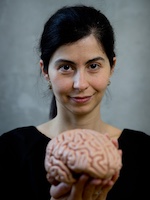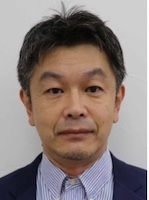Special Session

Michael J. Frank (Brown University)
[Website]
From Descriptive to Normative Accounts of Frontostriatal Control
The basal ganglia and dopaminergic (DA) systems are well studied for their roles in reinforcement learning, but the underlying architecture is notoriously complex. First, I will present a computational account of how this complexity is optimized to provide robust advantages over traditional reinforcement learning models over a range of environments, and suggest that empirical observations of altered learning and decision making in patient populations reflect a byproduct of an otherwise normative mechanism. Second, I will show how this system, when interacting with prefrontal cortex, can learn to influence cognitive actions such as working memory updating and “chunking” strategies that are adapted as function of task demands, mimicking human performance and normative models.
References :
1. Jaskir, A. & Frank, M.J. (2023). On the normative advantages of dopamine and striatal opponency for learning and choice. eLife, 12, e85107.
2. Soni, A. & Frank, M.J. (2024). Adaptive chunking improves effective working memory capacity in a prefrontal cortex and basal ganglia circuit. eLife, 13, RP97894.
3. Pagnier, G., Asaad, W.F. & Frank, M.J. (2024). Double dissociation of dopamine and subthalamic nucleus stimulation on effortful cost/benefit decision making. Current Biology, 34, 665-660.

Marta Garrido (Melbourne School of Psychological Sciences, Graeme Clark Institute for Biomedical Engineering, The University of Melbourne)
[Website]
The Insight of Blindsight
Much of what we know about brain circuitry for human vision comes from neuroimaging studies and investigations on people with brain damage. A remarkable example are the studies in blindsight patients, who despite being blind after injury to their primary visual cortex (V1), display remarkable visual abilities. Indeed, blindsight patients can navigate through obstacles, detect motion, and correctly identify emotion in unseen faces. A possible explanation for this apparent paradox is that visual information is conveyed from subcortical structures to other cortical regions, bypassing V1. In this talk, I will present converging evidence from a diverse range of neuroimaging techniques and large data sets, which show this is the case for behavioural salient stimuli charged with motion and emotion information (McFadyen et al., 2019 and Rowe et al., 2023). I propose that the brain circuitry underpinning such residual vision, albeit without awareness, relies on brain shortcuts. These shortcuts may be a means for expediency of information processing and a useful alternative for the preservation and rehabilitation of critical visual functions after brain insult (McFadyen et al., 2021).
References :
https://elifesciences.org/articles/40766
https://www.nature.com/articles/s41583-020-0287-1
https://pubmed.ncbi.nlm.nih.gov/37608684/

Naotsugu Tsuchiya (School of Psychological Sciences, Faculty of Medicine, Nursing, and Health Sciences, Monash University)
[Website]
The Qualia Structure Paradigm: towards a construction of a Qualia Periodic Table for the dissolution of the Hard Problem of Consciousness
The nature of the relationships between qualitative aspects of consciousness, or qualia, and their physical substrates remains unclear. The problem of qualia is one of the biggest challenges among the enigmas of consciousness. One difficulty in qualia research is characterization of qualia. Verbal descriptions and simple behavioral responses are unable to capture the richness of qualia, the dilemma faced by the traditional NCC paradigm. Comparing a quale with another quale, however, is not difficult. Such relational characterization of qualia, but now in a structural context, underlies the core of the Qualia Structure paradigm. This new paradigm was inspired by category theory, in particular, the Yoneda lemma, which states that an object in a category is characterized by its relationships to all objects in that category. Inspired by the lemma, the Qualia Structure paradigm proposes a pathway to characterize and organize the structural properties of different qualia one by one. As a result, it aspires to reach an organizing principle, akin to a Mendeleevian periodic table, for the domains of qualia and their physical substrates. Under this framework, any valid theories of consciousness should link the two domains in a structure-preserving manner. Successful refinement of such theories will lead to “natural” relationships among these different theories. This level of specification and understanding of relations between qualia and the physical would dissolve the Hard Problem of consciousness in its current form.
References :
https://osf.io/preprints/psyarxiv/492hu
Topic Session

春野雅彦(情報通信研究機構 NICT)
Masahiko Haruno (Neural Information Enginnering Laboratory Cneter for Information and Neural Networks, NICT)
[Website]
How using avatars changes our minds.
Avatars are increasingly shaping society. For example, a convenience store chain has implemented an avatar system that allows clerks to work remotely, providing opportunities for individuals with disabilities and those requiring flexible work arrangements. However, the impact of using avatars on human cognition and brain functions remains largely unexplored. In this presentation, we introduce our recent findings demonstrating that: (1) feedback from avatars influences human risk-
taking behavior, (2) action-based predictions based on virtual experiences contribute to the extinction of fear memories, and (3) using multiple avatars alters individual personal space.

小池進介(心の多様性と適応の連携研究機構、東京大学)
Shinsuke Koike (UTokyo Institute for Diversity & Adaptation of Human Mind (UTIDAHM), The University of Tokyo)
[Website]
Multi-site large-sample human brain MRI analysis for various psychiatric disorders
For more than 30 years, magnetic resonance imaging (MRI) has provided an understanding of psychiatric disorders. MRI signals can be divided into three key factors: measurement bias, arising from differences in MRI machines and protocols; non-disease-related sampling bias, influenced by the variations of age distribution and sex ratios in both case and control groups; and disease-related signals. The reduction of measurement and sampling biases from disease-related signals is crucial when exploring cross-disorder analysis using a multi-site dataset because the measurement and sampling biases usually provide a greater effect size compared to the difference between psychiatric disorders (Koike et al. NeuroImage Clin 2021; Maikusa et al. Hum Brain Mapp 2021; Yamashita et al. PLOS Biol 2020; Zhu et al. Schizophr Bull 2022; Zhu et al. Mol Psychiatry 2024). Furthermore, the clinical sites were unable to apply the standardized measurement procedure and eligibility criteria because of the restrictions of each research site (Shi and Koike. JMA J 2024). The AMED Brain/MINDS Beyond Human Brain MRI (BMB-HBM, FY2018-FY2023) project aimed to establish clinically relevant imaging biomarkers for neuropsychiatric disorders with high-quality harmonized data collection through the lifespan. We established high-quality multimodal scanning protocols, data sharing and preprocessing pipelines, and traveling subject harmonization data and techniques, which can only diminish measurement bias in the brain signals. In this project, we intend to publicly share more than 7000 samples targeting neuropsychiatric disorders and adolescent development. In this presentation, I intend to introduce the BMB-HBM project and ongoing multi-site 2000 sample harmonization and the analysis of brain structural features for people with schizophrenia, major depressive disorders, bipolar disorders, and autism spectrum disorders as well as clinical high risk for psychosis (Maikusa et al. under review). Finally, expanding to larger sample size, multimodal investigation, and more targeted conditions including neuropsychiatric disorders and development and aging will be discussed in the AMED Brain/MINDS 2.0 project.

花川隆(京都大学大学院医学研究科)
Takashi Hanakawa (Kyoto University Graduate School and Faculty of Medicine)
[Website]
Study of the tactile system with a novel haptic device
The tactile system on the skin is the most expansive yet least explored sensory system in humans. One of the reasons for poor exploration is the lack of adequate and convenient haptic devices that could elicit various tactile experiences. We developed arrayed, ultra-thin haptic devices called haptic mesh (HM), by which different vibration patterns can produce different tactile experiences in humans. To understand how the human neural system processes different vibration patterns to perceive different tactile experiences, we have started to measure brain and spinal cord activity with MRI. A preliminary result will be disclosed.

石原悠子(立命館大学 グローバル教養学部)
Yuko Ishihara (College of Global Liberal Arts, Ritsumeikan University)
[Website]
Nishida Kitaro’s Dynamic Account of Self-Consciousness: Resituating Nishida into Contemporary Debates
Self-consciousness, or self-awareness, can be understood as the awareness of oneself. But what exactly does it mean to be conscious of oneself? Contemporary philosophers distinguish between two forms of self-awareness: reflective and pre-reflective. Reflective self-awareness involves higher-order cognition, where one explicitly recognizes oneself as an object of thought. Pre-reflective self-awareness, by contrast, is a more immediate, implicit awareness—an intrinsic property of first-order experiences. For instance, when experiencing pain, one is pre-reflectively aware of oneself in pain before explicitly acknowledging that I am in pain upon reflection. Since we are not always reflecting, pre-reflective self-awareness represents a more pervasive and primitive form of self-awareness.
Philosophical debates on pre-reflective self-awareness focus on whether it involves higher-order representation or if it is an intrinsic, non-representational property of first-order mental states. The analytic tradition often interprets it as a higher-order representation (thought or perception) accompanying mental states, while the phenomenological tradition advocates a one level account, viewing pre-reflective self-awareness as immediately given.
In this talk, I introduce the Japanese philosopher Nishida Kitaro’s account of self-awareness as an alternative perspective. By situating his ideas within contemporary debates, I argue that Nishida offers a dynamic view of self-awareness, integrating representationalist and phenomenological approaches to self-awareness. His view not only bridges these competing frameworks but also enriches our understanding of the nature and structure of self-consciousness.
References :
https://www.tandfonline.com/doi/full/10.1080/09552367.2011.563995
https://link.springer.com/chapter/10.1007/978-3-030-92321-1_11

高木優(国立情報学研究所 大規模言語モデル研究開発センター)
Yu Takagi (National Institute of Informatics Research and Development Center for Large Language Models)
[Website]
Bridging Minds: Human Brain, Generative AI, and Foundational Models
Generative AI is rapidly advancing, demonstrating impressive capabilities in understanding environments, responding to complex instructions, and even interacting with its surroundings.
Despite rapidly approaching human-like abilities, generative AI differs from traditional human-inspired AI, and we still know very little about the computations it performs or how their “brains” resemble those of the human brain.
Our research explores how generative AI can contribute to understanding the human brain while applying cognitive neuroscience methods to understand the inner workings of generative AI.
In this talk, I will first discuss studies on the correspondence between human brain activity and generative AI across various modalities, followed by ongoing efforts to develop foundational models and uncover their principles through cognitive neuroscience techniques.

佐々木拓哉(東北大学大学院薬学研究科)
Takuya Sasaki (Graduate School of Pharmaceutical Sciences, Tohoku University)
[Website]
身体内部シグナルから考察する情動と脳情報処理
Emotion and information processing supported by interoceptive signals
Interoception is the process by which the brain network continuously receives internal sensations from peripheral organs. The vagus nerve is a core pathway to transmit interoceptive signals, which crucially affects emotions, decision making, and psychiatric disorders. However, the detailed neurophysiological dynamics of the vagus nerve in response to emotions and social behavior and its associated pathological changes remain unclear. We demonstrated that the activity of the cervical vagus nerve is reduced in stressed mice and correlated with the power of prefrontal cortical oscillations. The oscillations also underwent dynamic changes depending on the behavioral state. Chronic vagus nerve stimulation restored behavior-relevant neuronal oscillations with the recovery of altered behavioral states in stressed mice. These results suggest that physiological vagal-brain communication underlies emotional behaviors. Furthermore, we recently found that vagus nerve activity triggers neuronal activity in the hippocampus in addition to the prefrontal cortex. In this workshop, I discuss how internal reactivation of memories supported by prefrontal-hippocampal networks is related to vagus nerve-induced interoception.
References :
1. Kuga et al. Hippocampal sharp wave ripples underlie stress susceptibility in male mice. Nature Communications 14: 2105 (2023)
2. Okonogi et al. Stress-induced vagal activity influences anxiety-relevant prefrontal and amygdala neuronal oscillations in male mice. Nature Communications 15: 183 (2024)
3. How the brain senses the body. Nature, Nature index: Neuroscience 2024
